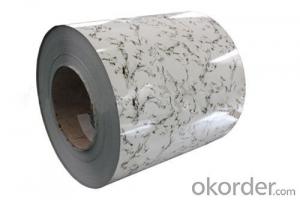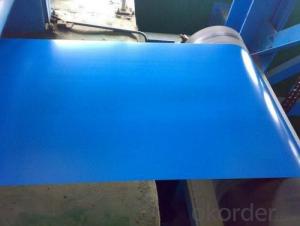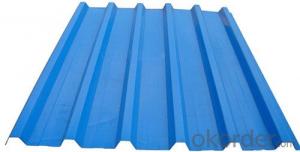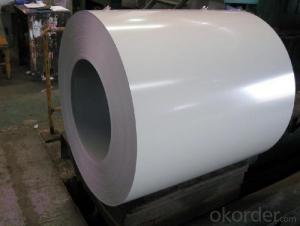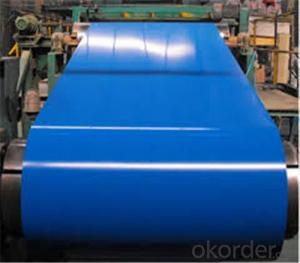Prepainted steel Coils, Hot-dipped Galvanized, RAL system, with good corrosion resistance
- Loading Port:
- Shanghai
- Payment Terms:
- TT OR LC
- Min Order Qty:
- 25 m.t.
- Supply Capability:
- 30000 m.t./month
OKorder Service Pledge
OKorder Financial Service
You Might Also Like
Dx51d PPGI Prepainted Color Galvanized Steel Coil
ISO System
SGS and BV Audited company.
Industry experience over 10 years.
Management Systems-Internal Software
Finished Product Inventory-More Than 500 Tons.
Raw Material inventory -Over 800 Mertic Tons.
Shipment of goods -More than 30 countries worldwide.
We have the most convenient transport and prompt delivery.
We offer competitive price with best service.
We have high technical production line with top quality products.
We have win high reputation based on best quality products.
Product Description
1, Introduction: Color coated steel coils(sheets), i. e. PPGI, also called prepainted steel coils(sheets), are made of galvanized steel coils(sheets) with polymer coatings as surface. It's a new enclosure material and building board with characteristics of light-weighted, heat preserved&insulated, easily installed with bright colors.
2, Production Process: Pretreatment(Degreasing)_Drying_Chromating_Paint Basic Oil_Cooling_Drying_Color Coating_Cooling_Film-covering_Rolling Up
3, Characteristics:
Good at corrosion resistence. Besides zinc coating of the basic plate of galvanized steel sheet, the color coating as the surface has double lifetime to ensure better anticorrosion effect.
with excellent cold bending molded manufacturablity, PPGI products can be processed or directly used as final product. As being light-weighted and conveniently transported, they're widly used to replace wood to save energy.
There're thousands of colors can be chosen as per different application. Any color plays well in decoration.
No pollution with high recycling rate, PPGI coils and sheets are strongly recommended as enviroment-friendly products by the government.
4, Appliance: Thanks to the above characteristics, color coated steel coils and sheets are widly used in construction, furniture industry, transportation industry, ect.
5, eye bands and 4 circumferential bands in steel, galvanized metal fluted rings on inner and outer edges, galvanized.
- Q: What are the challenges in coil recoiling for high-strength steel?
- Coil recoiling for high-strength steel presents several challenges that must be addressed. To begin with, high-strength steel possesses heightened hardness and strength, rendering it more difficult to coil than regular steel. The greater tensile strength of high-strength steel places additional strain on the recoiling machinery, potentially resulting in damage or machinery failure. Moreover, high-strength steel tends to exhibit reduced ductility, meaning it is less able to endure deformation without fracturing. Recoiling high-strength steel coils necessitates meticulous handling and control to prevent excessive bending or stretching that could lead to material breakage or cracking. Another obstacle arises from the shape memory effect of high-strength steel, whereby the material returns to its original shape after being deformed. Although this property can be advantageous in certain applications, it complicates the recoiling process as the steel coil resists reshaping into a new coil form. Furthermore, high-strength steel often possesses a more intricate microstructure compared to regular steel, characterized by various phases and grain boundaries. This complexity can heighten the difficulty of the recoiling process, as it can impact the material's mechanical properties and response to deformation. Finally, the surface finish of high-strength steel coils is crucial for many applications. Recoiling can introduce surface defects, such as scratches or marks, which may impair the functionality or appearance of the final product. Consequently, maintaining a high-quality surface finish during the recoiling process poses a significant challenge. In summary, the challenges associated with coil recoiling for high-strength steel encompass increased stress on recoiling equipment, reduced ductility, the shape memory effect, complex microstructure, and the need for a high-quality surface finish. Overcoming these challenges necessitates specialized equipment, precise control, and careful handling to ensure the integrity and quality of the recoiled high-strength steel coils.
- Q: How are steel coils used in the production of HVAC ductwork?
- Steel coils are commonly used in the production of HVAC ductwork due to their durability and strength. The coils are typically made of galvanized steel, which provides protection against corrosion and extends the lifespan of the ductwork. The manufacturing process begins with the steel coils being unrolled and cut into the desired length. The coils are then fed through a machine that shapes the steel into a rectangular or round duct form. This shaping process can be done using various techniques such as roll forming or press braking. Once the steel has been formed into the desired duct shape, it is then joined together using various methods such as welding or locking mechanisms. Welding is often used for rectangular ducts, while locking mechanisms like snap locks or Pittsburgh seams are commonly used for round ducts. These joining techniques ensure that the ductwork is secure and airtight. After the ductwork has been assembled, it may undergo additional processes such as insulation or lining. Insulation helps to reduce heat loss or gain, while lining can improve the acoustic properties of the ductwork. These additional steps are often done to meet specific requirements or regulations. Overall, steel coils play a crucial role in the production of HVAC ductwork as they provide strength, durability, and protection against corrosion. The versatility of steel allows for various shapes and sizes of ductwork to be fabricated, making it a popular choice for HVAC systems.
- Q: What are the different surface treatments applied to steel coils?
- Some of the different surface treatments applied to steel coils include galvanizing, which involves coating the steel with a layer of zinc to protect it from corrosion, painting or powder coating to enhance the aesthetics and provide additional protection, and passivation to remove any impurities on the surface and improve its corrosion resistance.
- Q: On a free standing carport with an 8 inch, 22 foot long aluminum i-beam, would a steel 8-inch i-beam be just as strong? I am looking into it since they are cheaper.
- steel is definitely cheaper than aluminum. for the same size, steel is stronger. and much heavier. it may/will require stronger support posts. you'll want to be careful not to set up a galvanic reaction where you have steel and aluminum meet. stainless steel is much more expensive. you just want to make sure your steel beams have a good rustproof coating. either zinc plate or paint.
- Q: How are steel coils classified based on their thickness?
- Steel coils are classified based on their thickness into different categories such as light gauge, medium gauge, and heavy gauge.
- Q: What are the common applications of steel coils?
- Steel coils have a wide range of applications in various industries such as automotive, construction, manufacturing, and energy. They are commonly used for making components and parts in vehicles, buildings, appliances, and machinery. Steel coils can also be employed in the production of pipes, tubes, and electrical appliances. Additionally, they are utilized in the energy sector for manufacturing power transmission equipment and storage tanks.
- Q: What is the maximum weight capacity for a steel coil lifting device?
- The maximum weight capacity for a steel coil lifting device depends on various factors such as the design, size, and specifications of the specific lifting device. It is crucial to refer to the manufacturer's guidelines or consult with a qualified engineer to determine the exact weight capacity for a particular steel coil lifting device.
- Q: Help please.What atoms are there in steel?Like water is equals to 1 Oxygen atom + 2 Hydrogen atoms.Thnx 4 d help.
- Steel is an alloy consisting mostly of iron, with a carbon content between 0.2 and 1.7 or 2.04% by weight (C:1000–10,8.67Fe), depending on grade. Steel is Fe(iron) and Carbon alloy. These are the atoms in certain ratio that make up steel. Its not a molecule but alloy.
- Q: Can steel coils be used in the production of HVAC systems?
- Certainly, HVAC systems can make use of steel coils. In the production of HVAC equipment, like air handlers, condenser coils, evaporator coils, and heat exchangers, steel coils are frequently employed. Their durability and strength make them well-suited to endure the rigorous pressures and temperatures involved in HVAC operations. Moreover, steel coils possess favorable heat transfer properties, facilitating efficient heat exchange between the refrigerant and the conditioned air. In summary, steel coils are an dependable and widely-utilized element in the manufacturing of HVAC systems.
- Q: gigantic navy ships made of steel float, why??
- Concrete boats also float, Capt Johns link explains that. It is area + weight + volume. Displacement. Buoyancy is achieved by Displacing fN or X.
Send your message to us
Prepainted steel Coils, Hot-dipped Galvanized, RAL system, with good corrosion resistance
- Loading Port:
- Shanghai
- Payment Terms:
- TT OR LC
- Min Order Qty:
- 25 m.t.
- Supply Capability:
- 30000 m.t./month
OKorder Service Pledge
OKorder Financial Service
Similar products
Hot products
Hot Searches
Related keywords
